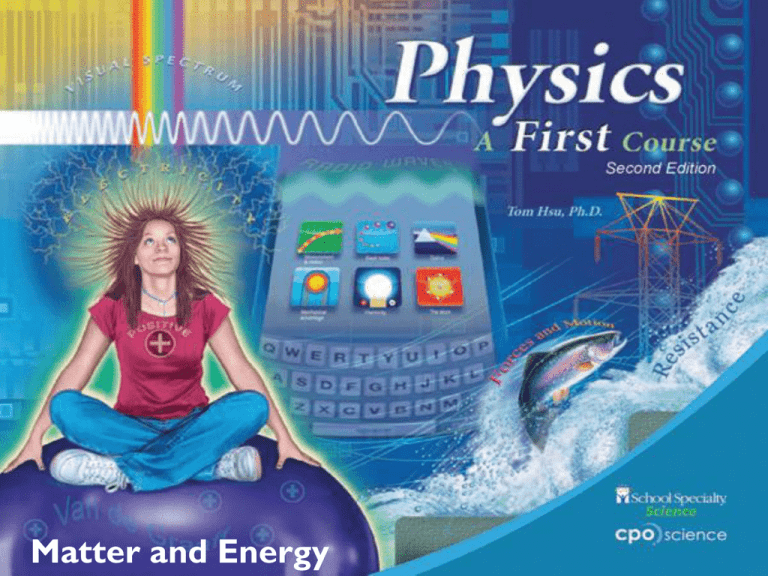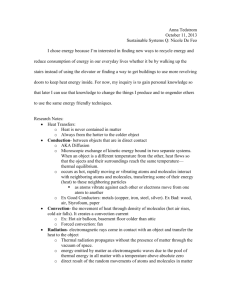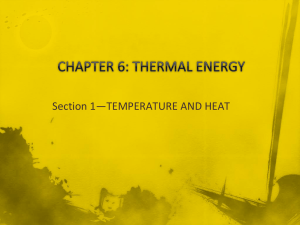Chapter 9: Matter and Energy
advertisement

Matter and Energy Unit 4: Matter and Energy Chapter 9: Matter and Energy 9.1 Matter, Temperature and Pressure 9.2 What is Heat? 9.3 Heat Transfer 9.1 Investigation: Temperature and Heat Key Question: How is temperature different from heat? Objectives: Describe the relationship between temperature and heat. Apply the heat equation to predict the final temperature of a mixture. Infer that different substances are able to store different amounts of heat. Matter and energy Greek philosophers Democritus and Leucippus proposed that matter is made of tiny particles called atoms. Atoms were an idea that few believed. Today we know sugar is made up of small particles called molecules and they are composed of atoms. The Nature of Matter Robert Brown first noticed the jerky motion of tiny particles. Throwing marbles at a tire tube moves the tube smoothly. Throwing the same marbles at a foam cup moves the cup in a jerky way, like Brownian motion. Varying the mass and size of particles that collide can have different effects. Atoms A single atom is the smallest particle that retains the chemical identity of the element. Elements An element is a pure substance that cannot be broken down into other substance by chemical or physical means. All of the matter you are ever likely to experience is made from one or more elements in nature. Atoms Sodium atoms are different from carbon, aluminum, oxygen or hydrogen atoms. They have different masses. Compounds and elements Compounds are two or more different elements chemically bonded together. Examples of compounds Compounds contain more than one type of atom joined together. Molecules A molecule is a group of two or more atoms joined together chemically. Mixtures Many substances you encounter are a mixture of different elements and compounds. How many atomsmolecules are in How many are this mixture? in this mixture? Elements, compounds, and mixtures Can you distinguish between the atoms and molecules in these images? Particles of matter and temperature Atoms are in constant motion, even in a solid object. Particles in a solid are connected by bonds that act like springs. Particles of matter and temperature Temperature measures the kinetic energy per molecule due to random motion. Intermolecular forces and temperature Neighboring atoms and molecules are attracted through intermolecular forces. The strength of the intermolecular forces determines whether matter exists as a solid, liquid, or gas at any given temperature. The phases of matter A solid holds its shape and does not flow. The molecules in a solid vibrate in place, but on average, don’t move far from their places. The phases of matter A liquid holds its volume, but does not hold its shape—it flows. Liquids flow because the molecules can move around. The phases of matter A gas flows like a liquid, but can also expand or contract to fill a container. A gas does not hold its volume. The molecules in a gas have enough energy to completely break away from each other. Melting and boiling The melting point is the temperature at which a substance changes from a solid to a liquid. Melting and boiling The temperature at which a liquid becomes a gas is called the boiling point. Phase change As energy is add to the system, the intermolecular forces grow weaker and the substance changes phase. Temperature scales There are two common temperature scales. On the Fahrenheit scale, water freezes at 32 degrees and boils at 212 degrees. The Celsius scale divides the interval between the freezing and boiling points of water into 100 degrees. Converting between temperature scales A French recipe says to bake the cake at a temperature of 200 °C for 45 minutes. At what temperature should you set your oven, which uses the Fahrenheit scale? 1. Looking for: … temperature in °F. 2. Given: … temperature (200C). 3. Relationships: Use: TF = 9/5 TC + 32 4. Solution: TF = (9/5)(200 °C) + 32 = 392 °F Absolute zero Absolute zero is -273°C. You cannot have a temperature lower than absolute zero. Think of absolute zero as the temperature at which atoms are “frozen.” Plasma In the plasma phase, matter becomes ionized as electrons are broken loose from atoms. The Sun is made of plasma, as is most of the universe, including the Eagle nebula. Particles of matter and pressure Like temperature, pressure is related to the motion of particles. Pressure liquids. is associated with fluids—gases and According to Newton’s third law, a equal and opposite forces are exerted by particles in a pitcher . The reaction force is what creates the pressure acting on the inner surface of the pitcher. Unit 4: Matter and Energy Chapter 9: Matter and Energy 9.1 Matter, Temperature and Pressure 9.2 What is Heat? 9.3 Heat Transfer 9.2 Investigation: Energy and Phase Changes Key Question: How is energy involved when matter changes phase? Objectives: Compare and contrast the properties of matter in the solid, liquid, and gas phases. Describe what happens, in terms of energy, when matter changes phase. What is heat? Heat and temperature are related, but are not the same thing. The amount of thermal energy depends on the temperature but it also depends on the amount of matter you have. Units of heat and thermal energy The metric unit for measuring heat is the joule. This is the same joule used to measure all forms of energy, not just heat. Heat and thermal energy Thermal One energy is often measured in calories. calorie is the amount of energy it takes to raise the temperature of one milliliter of water by one degree Celsius. Specific heat The specific heat is a property of a substance that tells us how much heat is needed to raise the temperature of one kilogram of a material by one degree Celsius. The apple filling in the pie has a higher specific heat than the crust. How do you know? Specific heat of various materials If the specific heat is high (like water), then the temperature will change relatively slowly because each degree of change takes more energy. Knowing the specific heat of a material tells you how quickly the temperature will change as it gains or loses energy. Calculating heat How much heat is needed to raise the temperature of a 250-liter hot tub from 20°C to 40°C? The specific heat of water is 4,184 J/kg·°C. (Hint: 1 L of water has a mass of 1 kg.) 1. Looking for: … heat. 2. Given: … tub temp. change (20 °C), tub volume (250 L) and you know the specific heat of water. 3. Relationships: Use: E = mCp(T2 – T1) 4. Solution: E = (250L × 1kg/L) × 4,184 J/kg°C (20°C) = 20,920,000 J Why is specific heat different for different materials? Temperature measures the average kinetic energy per particle. Energy that is divided between fewer particles means more energy per particle, and therefore more temperature change. In general, materials made up of heavy atoms or molecules have low specific heat compared with materials made up of lighter ones. Unit 4: Matter and Energy Chapter 9: Matter and Energy 9.1 Matter, Temperature and Pressure 9.2 What is Heat? 9.3 Heat Transfer Heat transfer Thermal energy flows from higher temperature to lower temperature. This process is called heat transfer. There are three ways heat flows: — heat conduction, — convection, and — thermal radiation. Heat conduction Heat conduction is the transfer of heat by the direct contact of particles of matter. Conduction Where is the heat energy conducted to and from in this system? occurs between two materials at different temperatures when they are touching each other. Thermal equilibrium Thermal equilibrium occurs when two bodies have the same temperature. No heat flows in thermal equilibrium because the temperature is the same in the two materials. Thermal conductors and insulators Materials that conduct heat easily are called thermal conductors and those that conduct heat poorly are called thermal insulators. Is a down coat a conductor or an insulator? Convection Convection is the transfer of heat through the motion of matter such as air and water. The hot water at the bottom of the pot rises to the top and replaces the cold water. Convection Convection is mainly what distributes heat throughout a room. Thermal radiation Heat from the Sun is transferred to Earth by thermal radiation. All the energy the Earth receives from the Sun comes from thermal radiation. The higher the temperature of an object, the more thermal radiation it emits. Thermal radiation Thermal radiation is also absorbed by objects. The amount of thermal radiation absorbed depends on the surface of a material. Silvered or mirrored surfaces reflect thermal radiation. Dark surfaces absorb most of the thermal radiation they receive. The rate of heat transfer Heat transfer always occurs from hot to cold until thermal equilibrium is reached. The rate of heat transfer is proportional to the difference in temperature. Heat flow continues as long as there is a temperature difference. Gear up for a Space Walk Earth’s atmosphere does a lot more to help humans maintain homeostasis (internal balance) than just providing oxygen. It keeps global temperatures within a narrow range, shields us from harmful radiation, breaks up most meteoroids, and provides the pressure our bodies need to function properly.








